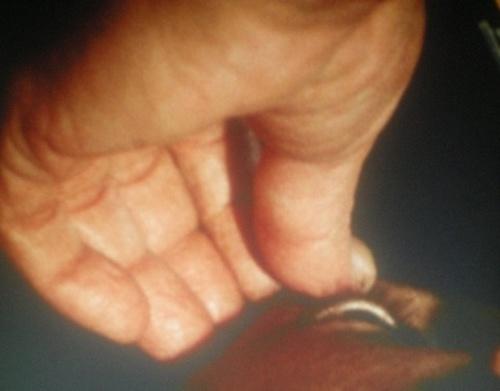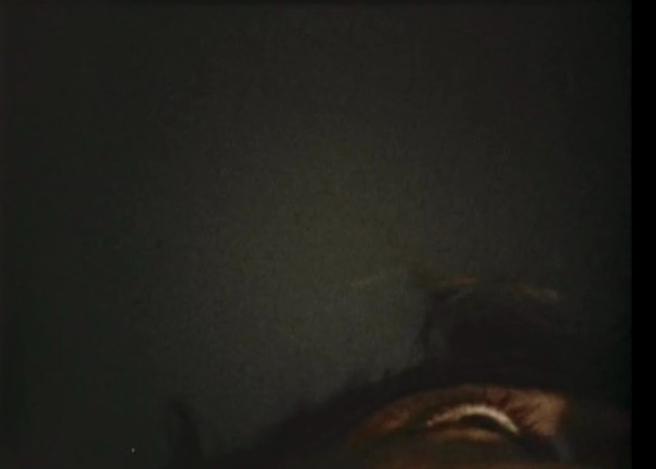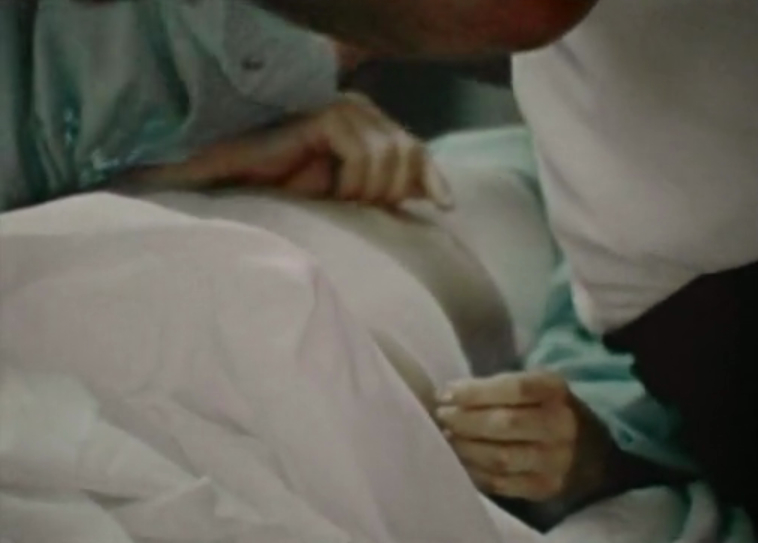Notes for National Corpse Month, Part Three

Three springs ago, I taught a class on documentary poetics. It met in the library of a literary/arts organization near downtown Tucson, Arizona. At the first meeting I showed Stan Brakhage’s The Act of Seeing With One’s Own Eyes (1971): a thirty-two minute film documenting autopsies being performed in a morgue in Pittsburgh. I gave a brief introduction then plunged the library into darkness.
Should I reiterate the autopsies? No—here’s the film.
I’m going to watch it too:
••••••••••••••••••••••••
In the beginning, there are corpses. The corpses are neither old nor visibly wounded. They appear as living people under hypnosis, or performing. We recognize the corpses because we do not depend upon them being dead. Besides, they are only acting.
In the beginning, there are living people. The living people tend to the corpses. They take the corpses' measurements with yellow rulers. They tend in doctor fashion.
The corpses are not sleeping, but in a state of death intoxication. Intoxicated by death, yet deathless ...
The animating contingency of death stripped away.
Then the corpses are opened.
The living people drill and drain the corpses. The corpses are pliable and compliant. Hair is pathetic. The flaying of the corpse permits the final vestige of performance to fall away. Skin is a suit, a costume, without inhabitant inside. When a forehead is pulled over a man’s face to expose the brain, the camera crosses its eyes. It is difficult to watch the living handle the dead without forcing oneself into self-preserving distraction, but it is imperative to stay focused.
Suicides arrive. Murders arrive.
The corpses are butterflied.
Ribs are removed. Breastplates are removed. Faces are removed.
Even the corpses are removed.
There is no sound.
Late in the film we see a corpse we recognize: that of an old person. We expect to see the corpse of an old person because we already perceive the old person as immediately antecedent to a corpse. The corpse is gray and stiff yet loose and slipping.
••••••••••••••••••••••••
One minute before the end, a small lake appears. Bodily humors shine upon the corpse. I think of the inaccessible lakes that fertilize the Alps, where my parents married in 1972.
Untouched, their depth is blood.
••••••••••••••••••••••••
After the film, we discussed what we saw. One of the students—a woman in her sixties—felt my showing the film was disrespectful. She took umbrage at how graphic it was, and said I had not adequately prepared the class. But more specifically, her friend’s father just died. Her friend—sitting beside her; she was also in the class—did not say a word; the woman was speaking for both of them. I had disrespected their grieving. And the dead father too—his death. I listened and asked questions and other people responded, but the woman’s discomfort quickly turned to anger, and her grief, empowered by her friend’s silence, overtook the library. I struggled to return the conversation (argument) to the fact of the film as a document, first, and not as some kind of memento mori, but the temperature rose and the class degenerated beyond recovery into chaos. Or, I never recovered—which was my failing. I sympathized with the woman’s friend, more than with the woman. The woman's anger was proud and ultimately disinterested—even, it seemed, in her friend. And yet, I’m still thinking about this woman.
••••••••••••••••••••••••
Why ...
Am I still thinking about this woman?
While simultaneously missing the corpses?

No one looks at the corpse
Everyone not-looks at the corpse
—Kate Zambreno, O Fallen Angel
Or the fog that surrounds you like the awareness of death when you face the corpse
—Jackie Wang, Because There Is Silence
The corpse again and again refused to die.
—Etel Adnan, In the Heart of the Heart of Another Country

Stan Brakhage wanted to go to the moon. Instead, he went to Pittsburgh. He wanted to film situations that were—as Robert Creeley said (1982)—“paradoxically absent from the information” people experience in their daily lives, yet fundamental to them.
The Act of Seeing With One's Own Eyes is not an act of the imagination, which is the landscape of grief. Grief works its way through the trauma of death by way of the imagination. The trauma of death multiplies when deprived of the security of the imagination, especially when the imagination is unexamined and uncontested. Unexamined and uncontested imagination is an ASYLUM (false security), which enables disrespectful—incomplete—relationships with the living.
It seemed less a matter of disrespecting the living than of rejecting the dead. Confronted with the innumerable facets, and challenges, of the corpse, the woman folded in upon herself to manifest an incoherent grief. Incoherent because vicarious. Therefore hectic. I believed it came from somewhere, but it was beyond the present situation.
••••••••••••••••••••••••
Rejecting death, at least ...
The woman admitted to not having been prepared ...
For what she saw ...
But who among us was?

Just because I am aware
does not mean I want to be
a woman object corpse no
matter how much I say I want or like it
that does dues to the odium.
—Cassandra Troyan, Kill Manual
"where the woman" "had lain—"
"defined by dispersed eyes" "as a corpse
shape" "but empty
black space—"
—Alice Notley, The Descent of Alette

When I originally submitted this post, it included the name of the literary/arts organization where I taught. The Poetry Foundation asked that I remove it. The organization will therefore be referred to here as: The Butcher Shop.
At the time of The Act of Seeing With One’s Own Eyes, the Butcher Shop—which doubles as a private residence—was being fumigated for bed bugs. One of the casitas was infested—stacks of bed bugs, is how the scene was described. The complex had been colonized, including the library. The shelves were empty. The books were removed—for safekeeping or had the library already been ravaged? The light of the morgue encompassed the walls and empty shelves. The library became a transitory morgue, inside and out—a gelid incarnation of Pittsburgh.
••••••••••••••••••••••••
For two years, The Butcher Shop was the venue for a reading series run by a man who had been stalking and harassing my partner since 2007, and who called and still calls himself The Butcher. My partner amassed years' worth of documented evidence, including a police report, and reams of invasive, threatening, and kaleidoscopically sociopathic emails. The Butcher Shop was first informed of this in 2008. My partner was friends with them, and had lived there that summer. She reiterated her concern again towards the end of 2011, in advance of a reading she was giving. The Butcher Shop was informed as friends, community organizers, and as people who had committed themselves to fostering a safe space within the literary community, and they responded with like concern and sympathy.
Sometime between the end of 2011 and the beginning of 2013, The Butcher Shop agreed to host a reading series run by The Butcher. His series ran from January 2013 through the end of 2014. When viewed in even the most positive light, the situation seemed basically counter-intuitive and deeply disturbing. How could this been seen as anything but a mandate for his behavior?
The last thing people want to admit is their complicity in the creation and maintenance of an environment that makes criminal behavior possible. Criminal behavior lapsed into the realm of the subjective, because a safe space had been created after all, though paradoxically not for those who most feared for their safety.
A safe space had been created for the harasser, the stalker, the butcher, the man.
My partner reiterated her concern again in the fall of 2014. Throughout the ordeal—which spun into meetings, cease-and-desist orders, threats of legal action, defensiveness, denial, deflective rhetoric, silencing, revisionism, factionalism, grandstanding, and most importantly fear, self-doubt, and isolating pain—I thought of my student, the woman who responded so strongly to The Act of Seeing With One's Own Eyes. There was something that continued to trouble me about her response—something that exceeded the woman herself. I recognized that because of my actions, she too had felt unsafe. And it wasn't a matter of mixing an apology with a desire to ask the woman to go even further into her anger, but of thinking about the cycles of dehumanization that seemed an expression of the mundane vacuum of the fumigated library.
••••••••••••••••••••••••
In the beginning, there are living people. In the beginning, there are also corpses. There are corpses and living people in The Act of Seeing, and living people and corpses in the library watching The Act. The corpses manifest the physical bodies of the living in ways that fundamentally resist the living people's projections. The living have a rendezvous with a corpse, until the corpse reciprocates—on its terms: the terms of unimaginative death. The corpses exclude the living, alienating them from their own physical bodies. The living are left to grieve before a body that is not a corpse, but the repression of the body in another form.
The corpse does not promote or complement one's solemn, insular grieving, but isolates it in a mundane vacuum.
Grieving manifests the unconscious desire to dehumanize the body by enshrining it in eternal life—a deathless angel state. Grieving insists that it is love, but it is closer to a misanthropic reaching through thwarted love toward phantasmagoria.
It is not that the living think the dead are still alive—though there are some living that do, and some dead that are—but the conscious mind insists upon memorializing the dead as they were when they were alive.
Memory has internalized the Resurrection, and has become a form of sorcery and/or black magic.
Once the corpse is rejected, the body is diffused; withheld from itself, it becomes arrested, and vulnerable, even more vulnerable than the corpse appears to be to the living, who are nevertheless the unthinking patrons of the ultimate alien state.
When the body is diffused, it becomes indistinguishable from other bodies, and therefore prey—prey to a predatory grief, which, isolated, and in the throes of attempting to impose itself upon a body that has been diffused, becomes incoherent, and lashes out. The voice of predatory grief is loud, and given privileged space. The voice of predatory grief radiates off other incoherent bodies, with which it seeks in desperation to form a community ...
Familiarly ...
••••••••••••••••••••••••
The moment community tries to incarnate itself in an isolatable subject, in a distinct, separate reality, the moment it tries to materialize the separation between what is inside it and what is outside, it confronts its own impossibility. The point of impossibility is communion. (Tiqqun, Introduction to Civil War, translated by Alexander R. Galloway and Jason E. Smith)
••••••••••••••••••••••••
The grieving predator, the deathless angel, prideful anger, the stalker, the butcher, and bloodsucking bugs, are bonded in the library without books. With no door to the outside world, the library becomes a situation room and/or meat locker. A library without books is only a promise—broken or outstanding. The implication is that a library, in order to be always a library, evades nascent life. It is a reincarnation or the consequence of an immaculate conception (or both); the death of ALL authors or their never having been born.
••••••••••••••••••••••••
To admit complicity in the creation and maintenance of an environment that makes criminal behavior possible: poetry is also complicit, poetry has always been complicit, poetry has always been the environment.
Poetry has the capacity, at least ...
To elide the corpse ...
To dehumanize the body and elide the corpse ...
Even as poetry immerses itself in the aura of the corpse's fact.
The occasion of poetry has made—makes—possible the dehumanization of the body through predatory grieving—the loss of one's own body, the loss of another's body, the loss of all bodies. Because: if a corpse is not real, neither is the living body.

The corpse, meanwhile, has other ideas ...
As does poetry. Poetry is of another mind ...
As is the corpse. The corpse is of another mind ...
The Act of Seeing With One's Own Hand, for example ...
Pointing with one hand to the hole made by the other ...
The fist, the vase, the urn, the emptiness ...
To what is the corpse holding on?
With what is the corpse holding on?

TO BE CONTINUED ...
[SEE ALSO: Notes for National Corpse Month, Part One]
[AND ALSO: Notes for National Corpse Month, Part Two]
Brandon Shimoda (he/him) is the author of several books of poetry and prose, including The Grave on …
Read Full Biography

